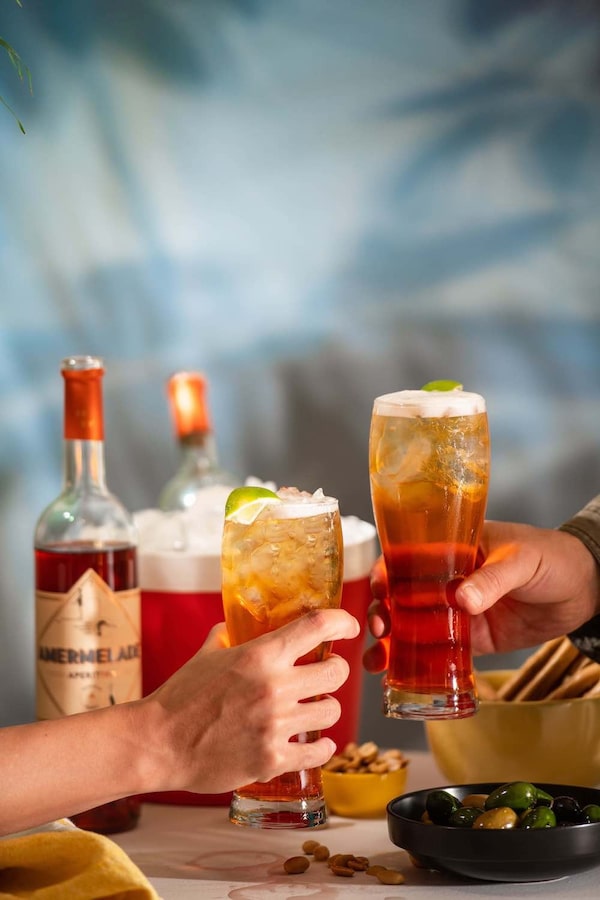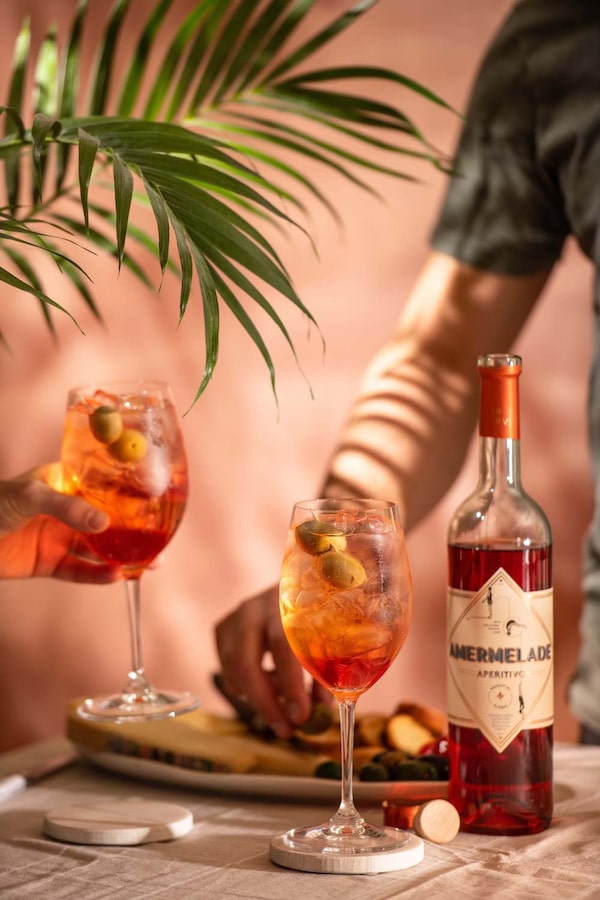
The vibrant, gentian-based orange apéritif Amermelade is a bittersweet sip made in Quebec.Courtesy of manufacturer
For moderate drinkers and their hosts, the question that looms right now is how to navigate get-togethers during the holiday season – that juggernaut between Sober October and Dry January – without getting clobbered after a couple of three-ounce cocktails. The goal: to find something that can sipped at day-long holiday open houses and festive work functions that doesn’t result in the need for an immediate nap.
There are signs that the drinks industry is catching on to the desire for lighter beverage options. After 250 years of being exclusively rooted in alcohol, behemoth beverage company Diageo recently acquired a majority stake in Seedlip, the premium distilled non-alcoholic spirit. It’s a necessary response to premium cocktail bars stepping up their abstemious offerings. Over a recent lunch at Toronto’s Alobar, for example, I sipped a refreshing cocktail made with herbaceous Seedlip Garden 108 and just a glancing splash of gin. Scottish drinks group William Grant & Sons – parent company of Hendrick’s, the Balvenie, and Glenfiddich – now also distills an ultra-low-alcohol spirit called Atopia (less than 1 per cent alcohol by volume). And bartender and vermouth specialists Shaun Byrne and Nick Tesar have launched a new book of creative low- and no-alcohol drinks, All Day Cocktails, which places an emphasis on the ritual of drinking rather than on alcohol content. It’s a deft substitution, positioning the low-ABV category not as an act of deprivation but as a positive social development.
Essentially, what December needs, and increasingly what drinkers are demanding, is aperitivo. Yes, I know it’s cold outside. But the sober-curious influence dovetails with a growing year-round appreciation of lighter drinks. La dolce vita lifestyle, which has weathered the transition into fall and its aromatized wines, vermouth and bitter spritz, continues to tint happy hour in vivid sunset shades of yellow and orange.
“We associate it with patio weather but it’s definitely steady,” says Jessica Hoffmann, long-time bartender at YEW in Vancouver. She presides over the daily aperitivo hour at the Four Seasons Hotel Vancouver and says it continues to thrive well into autumn thanks to its lighter cocktail menu – think classic Italian bitter Aperol concoctions rounded out with soda and fresh pineapple or cucumber juice.
Even lightening up traditional cocktails to suit near-abstainers, Hoffman says, can be something as simple as “doing a reverse Manhattan, meaning more white vermouth and less rye but still with Angostura bitters. It’s a fun play on it,” she explains. Or there’s her own creation, the Madame Collins, a riff on the classic Tom Collins where the flavours are built around just one ounce of gin.

Spirits like Amermelade are benefiting from the growing popularity of aperitivo brands.Courtesy of manufacturer
In Canada, Campari Group, owner of both the namesake drink and of Aperol, has done more than its share to educate the bitter palate and normalize lighter tippling. Last year, in addition to a big marketing push, it launched a month-long Aperol Spritz bar over the summer. That investment in awareness is now benefiting the category’s fledgling homegrown aperitivo brands.
If you’re having a spritz at Montreal’s Garde Manger, for example, it’s probably made with Amermelade, Quebec’s answer to Aperol. It’s a witty portmanteau: Amer is French for bitter, with “melade” a play on marmalade, for its pronounced citrus zing. The vibrant, gentian-based orange apéritif is a bittersweet sip ($21.30 at Quebec’s liquor retailer, SAQ) that’s made locally by Les Spiritueux Iberville and has stealthily grown in popularity since its 2017 launch.
They aren’t the only brand benefiting. “We couldn’t be more thrilled for what Campari Group is doing bringing attention to the spritz and to aperitif culture,” says Joel Clarke, principal in Affino Aperitivo, a sweet and bitter liquor. “They’ve done a lot for all of us.” Clarke saw an opportunity to expand Canadian craft offerings in the category this August when he launched the brand in partnership with Beamsville, Ont.-based Dillon’s Distillers. “I think people are looking for alternatives to high-octane vodka sodas and even gin and tonic, and cocktails – especially at lunch,” he says.
Les Spiritueux Iberville president Mario D’Amico agrees: “There has become a curiosity for aperitivo, which has created the demand.” Last month, he says, their star tipple did 67 per cent of Aperol sales in Quebec, “and overall for the year we’re doing 30 per cent of their sales. Never in my wildest dreams!” he says. Especially considering Amermelade’s origins began as a homemade elixir given out to friends and family at Christmas.
The company’s growing and proudly Italo-Quebecois craft spritz range includes Amermelade, which combines resinous sweet gale and tart sea buckthorn with fennel, eucalyptus, and orange; and its more bitter sibling Amer Amer (25 per cent ABV), which opts for rhubarb, rosemary and black spruce. In time for the holidays, Les Spiritueux Iberville has just expanded distribution into Ontario through a private agency. For its part, Affino’s zesty bitter gentian base rounds out with appetite-whetting macerated lemon peel, cinnamon and bitter orange. At 16 per cent it, too, is meant to be sipped in diluted combination with your favourite sparkler.
If the US$1-million in pre-seed funding that helped launch this year’s lower-alcohol startup darling Haus is any indication, these domestic brands are on the right track. Haus, the Sonoma County-based range of wine-based apéritif, was similarly created to both encourage and capitalize on the growing drinks trend as well as solve the problem, according to co-founders Helena and Woody Hambrecht, of “too much alcohol, too many hangovers.”
And there’s another benefit, in addition to the inherent moderation, that comes with aperitivo: Clarke points out that the accessibly priced category comes with a budget-conscious bonus that’s especially welcome at this expensive time of year. Unlike entertaining a crowd with a mid-range gin or vodka, “you can stretch a bottle of aperitivo pretty far with soda or Prosecco,” he says, adding that with just two elements a holiday spritz is also a no-brainer because you don’t have to be a mixologist either.
Plan your weekend with our Good Taste newsletter, offering wine advice and reviews, recipes, restaurant news and more. Sign up today.